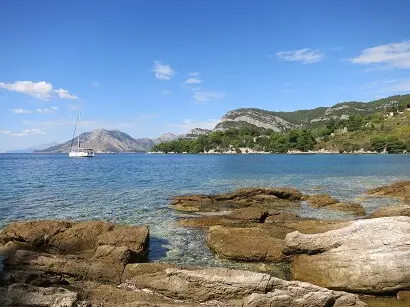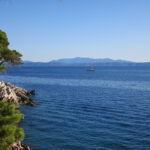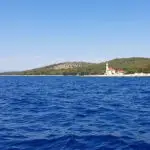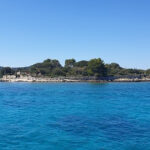If you’ve been thinking about holidaying in Croatia, but want to be sure that you’re going to be able to spend plenty of time soaking in the sun, sand, and sublime warm water of the Adriatic, the odds are pretty good you’ve questioned just how warm the beaches are in this part of the world.

Well, we have some good news for you!
Though the beaches in Croatia may not be quite as hot as favorite holiday destinations closer to the equator the beaches here are still quite warm – especially if you are visiting during the summertime months.
Let’s jump right in!
Does Croatia Have Warm Beaches? You bet – Here are some of the best!
Croatia enjoys moderate Mediterranean temperatures pretty much all year round, fluctuating from lows in November from around 50°F to highs in August close to 90°F. But for the most part, the temperatures hover in the “sweet spot” temperature zone between 68°F and 78°F pretty consistently.
Below we highlight some of the very best warm beaches Croatia has to offer, the kinds of beaches you’re going to want to make a prominent part of your travel itinerary to this part of the world.
Hvar Beach
Universally beloved as one of the very best beaches in all of Croatia, Hvar belongs at or near the top of every single travel itinerary to this part of the Adriatic Sea.
A beautiful island that has absolutely everything you could hope for when on holiday – luxurious accommodations, delicious food, incredible entertainment, shopping opportunities, etc. – the beaches surrounding this island are downright stunning – and pretty warm all year round.
The average temperature for these beaches sits at 73°F, though it’s not at all unusual for temperatures to get much closer to 85°F (or higher) during the summer months.
Make sure to check out our article on “Split to Hvar Ferries” for all the insider tips on the best ferry options for your trip from Split to the stunning Hvar Island.
Paradise Beach
One of the largest beaches in all of Croatia, Paradise Beach (measuring nearly a full 1.5 miles long), this beach headlines a lot of the travel and tourism advertisements coming out of Croatia – and for good reason.
Winning the prestigious “Blue Flag” award for water quality, as well as the preservation of natural surroundings and safety for visitors, Paradise Beach is a pretty regular mainstay on the Top 100 World Beaches list published annually by the folks at CNN.
The big allure of Paradise Beach as to be the almost endless opportunity for folks to enjoy this outdoor space exactly the way they want to. Those looking for more active visits to the beach are going to be able to play volleyball, go parasailing, or just run around and exercise on the beach.
Those looking for a more relaxed visit, though, can find a spot to soak up the sun and do a bit of tanning, too!
Old City of Dubrovnik
The average daily temperature at this beach in Croatia sits at about 72°F, though again it’s not at all unusual for this beach to warm up quite a bit more than that – sometimes heading 85°F (and higher) with some regularity in the summer.
Water temperatures, however, are a little bit on the cooler side of things. These temperatures in the Old City of Dubrovnik sit at around 66°F. That’s the water warm enough to swim in, though there are certainly warmer bits of coastline that folks in Croatia can seek out if they find this to be too chilly.
Lumbada Beach
Average daily temperatures at this beach in Croatia are right around 74°F, with about 6.5 hours of sunlight shining down on the beach throughout the year. In the summer, temperatures are a little bit higher and you get more sunshine – but even in the wintertime, you’re not going to find this beach all that cold.
The villages that are built around the beaches in this part of Croatia are a huge draw for international tourists. The culture is distinct, the food is incredible, and the number of outdoor activities you’ll find to enjoy here is almost endless.
Beaches of Brist
Located right next to the town of the same name (a smaller Croatian village near the Makarska Riviera), this beach is a little bit on the smaller side of things – but it’s a huge draw for travelers because of the unique natural features here, the unique culture, and the absolutely fantastic weather nearly all year round.
This beach is not the sandy beach you might be expecting. Instead, there are small pebbles littered throughout the sand, larger rocks and boulders jutting out of the sea, and little coves and breakers that really add a lot of charm, a lot of interest, and a lot of natural wonder to this spot.
All that said, it’s not hard to find a place to lay out on the beach and soak up some sunshine if you want to. The Adriatic is right there if you want to take a dip to cool down, too.
Beaches of Betina
Average daily temperatures on these beaches sit around 70°F all year round, which makes these beaches relatively warm – but not necessarily the warmest in all of Croatia.
Even still, these beaches (and the village of the same name located just off the coastline) are still a huge draw for tourism. There’s a lot of history here, there’s a ton of culture, and some of the best restaurants in Croatia can be found just a few steps off of the beach coastline.
Closing Thoughts
At the end of the day, if you are hoping that there are going to be warm beaches in Croatia for you to stretch out and relax on you are in luck!
Croatia may not have the same “beach tourism” reputation that vacation hotspots like the Caribbean have, but these beaches aren’t ice cold or even chilly most of the year.
Instead, these beaches are downright warm and inviting almost all year round. If you’re going to be visiting the beaches specifically do try to visit in the summertime months (June through August are the warmest of the year), but even visitors showing up in the winter aren’t going to be disappointed by the Croatian beach experiences we highlighted above.
- The Top Restaurants Specializing in Truffle Dishes - August 10, 2023
- Truffle Panna Cotta: A Decadent Dessert Recipe for Truffle Lovers - August 7, 2023
- Truffle Scrambled Eggs: A Luxurious Breakfast Delight - August 7, 2023








